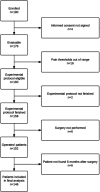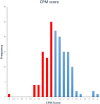Conditioned pain modulation predicts persistent pain after knee replacement surgery
- PMID: 33817538
- PMCID: PMC8009638
- DOI: 10.1097/PR9.0000000000000910
Conditioned pain modulation predicts persistent pain after knee replacement surgery
Abstract
Introduction: Persistent pain after total knee replacement is an underestimated outcome leading to significant health burden. Sensory testing has been explored to help surgeons in decision making and better patient selection. Patients with different chronic pain syndromes exhibit a poor descending pain inhibition that can be quantified through experimental paradigms (conditioned pain modulation). A poor preoperative descending pain inhibition response predicted persistence of pain after surgery in previous studies.
Methods: This study investigated the correlation between a preoperative inefficient endogenous analgesia and a bad postoperative pain outcome (painful prosthesis). One hundred forty-six patients were studied preoperatively by quantitative sensory testing. Conditioned pain modulation was calculated as the relative decrease in pain intensity (thermal stimulus) during heterotopic painful stimulation.
Results: Approximately 21.2% of patients had a bad pain outcome (painful prosthesis), 6 months after surgery. Preoperatively, 47.9% of patients exhibited an insufficient endogenous analgesia. The probability to develop persistent pain after surgery in that group was higher than that in patients with a sufficient endogenous analgesia (31.4% [20.9-43.6, 95% CI] vs 11.8% [5.5-21.3, 95% CI], respectively; P < 0.004). Correlation between conditioned pain modulation values and postoperative intensity of pain was also established. Besides, a preoperative lower quality of life (mental component) predicted a worse pain outcome, too.
Conclusions: This cohort study shows that preoperative sensory testing predicts a bad pain outcome after total knee replacement. This tool could help clinicians in a better indication of patients with advanced knee osteoarthritis for replacement surgery.
Registration details: ClinicalTrials.gov: NCT01811888 (prospective).
Keywords: Conditioned pain modulation; Hyperalgesia; Knee osteoarthritis; Persistent postsurgical pain.
Copyright © 2021 The Author(s). Published by Wolters Kluwer Health, Inc. on behalf of The International Association for the Study of Pain.
Conflict of interest statement
The authors have no conflicts of interest to declare.Sponsorships or competing interests that may be relevant to content are disclosed at the end of this article.
Figures
References
-
- Buvanendran A, Della Valle CJ, Kroin JS, Shah M, Moric M, Tuman KJ, McCarthy RJ. Acute postoperative pain is an independent predictor of chronic postsurgical pain following total knee arthroplasty at 6 months: a prospective cohort study. Reg Anesth Pain Med 2019;44:e100036. - PubMed
-
- Crombie IK, Davies HT, Macrae WA. Cut and thrust: antecedent surgery and trauma among patients attending a chronic pain clinic. PAIN 1998;76:167–71. - PubMed
-
- Culliford D, Maskell J, Judge A, Cooper C, Prieto-Alhambra D, Arden NK; COASt Study Group. Future projections of total hip and knee arthroplasty in the UK: results from the UK Clinical Practice Research Datalink. Osteoarthr Cartil 2015;23:594–600. - PubMed
Associated data
LinkOut - more resources
Full Text Sources
Other Literature Sources
Medical
Research Materials


